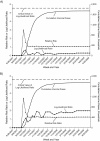Near real-time surveillance for influenza vaccine safety: proof-of-concept in the Vaccine Safety Datalink Project
- PMID: 19965887
- PMCID: PMC2878099
- DOI: 10.1093/aje/kwp345
Near real-time surveillance for influenza vaccine safety: proof-of-concept in the Vaccine Safety Datalink Project
Abstract
The emergence of pandemic H1N1 influenza in 2009 has prompted public health responses, including production and licensure of new influenza A (H1N1) 2009 monovalent vaccines. Safety monitoring is a critical component of vaccination programs. As proof-of-concept, the authors mimicked near real-time prospective surveillance for prespecified neurologic and allergic adverse events among enrollees in 8 medical care organizations (the Vaccine Safety Datalink Project) who received seasonal trivalent inactivated influenza vaccine during the 2005/06-2007/08 influenza seasons. In self-controlled case series analysis, the risk of adverse events in a prespecified exposure period following vaccination was compared with the risk in 1 control period for the same individual either before or after vaccination. In difference-in-difference analysis, the relative risk in exposed versus control periods each season was compared with the relative risk in previous seasons since 2000/01. The authors used Poisson-based analysis to compare the risk of Guillain-Barré syndrome following vaccination in each season with that in previous seasons. Maximized sequential probability ratio tests were used to adjust for repeated analyses on weekly data. With administration of 1,195,552 doses to children under age 18 years and 4,773,956 doses to adults, no elevated risk of adverse events was identified. Near real-time surveillance for selected adverse events can be implemented prospectively to rapidly assess seasonal and pandemic influenza vaccine safety.
Figures


Similar articles
-
The Vaccine Safety Datalink: successes and challenges monitoring vaccine safety.Vaccine. 2014 Sep 22;32(42):5390-8. doi: 10.1016/j.vaccine.2014.07.073. Epub 2014 Aug 6. Vaccine. 2014. PMID: 25108215 Free PMC article. Review.
-
H1N1 and seasonal influenza vaccine safety in the vaccine safety datalink project.Am J Prev Med. 2011 Aug;41(2):121-8. doi: 10.1016/j.amepre.2011.04.004. Am J Prev Med. 2011. PMID: 21767718
-
Safety of influenza A (H1N1) 2009 monovalent vaccines - United States, October 1-November 24, 2009.MMWR Morb Mortal Wkly Rep. 2009 Dec 11;58(48):1351-6. MMWR Morb Mortal Wkly Rep. 2009. PMID: 20010511
-
International collaboration to assess the risk of Guillain Barré Syndrome following Influenza A (H1N1) 2009 monovalent vaccines.Vaccine. 2013 Sep 13;31(40):4448-58. doi: 10.1016/j.vaccine.2013.06.032. Epub 2013 Jun 14. Vaccine. 2013. PMID: 23770307
-
Safety of seasonal influenza and influenza A (H1N1) 2009 monovalent vaccines in pregnancy.Expert Rev Vaccines. 2012 Aug;11(8):911-21. doi: 10.1586/erv.12.72. Expert Rev Vaccines. 2012. PMID: 23002972 Review.
Cited by
-
Near real-time adverse drug reaction surveillance within population-based health networks: methodology considerations for data accrual.Pharmacoepidemiol Drug Saf. 2013 May;22(5):488-95. doi: 10.1002/pds.3412. Epub 2013 Feb 12. Pharmacoepidemiol Drug Saf. 2013. PMID: 23401239 Free PMC article.
-
Risk of confirmed Guillain-Barre syndrome following receipt of monovalent inactivated influenza A (H1N1) and seasonal influenza vaccines in the Vaccine Safety Datalink Project, 2009-2010.Am J Epidemiol. 2012 Jun 1;175(11):1100-9. doi: 10.1093/aje/kws195. Epub 2012 May 11. Am J Epidemiol. 2012. PMID: 22582210 Free PMC article.
-
Influenza vaccines licensed in the United States in healthy children: a systematic review and network meta-analysis (Protocol).Syst Rev. 2012 Dec 29;1:65. doi: 10.1186/2046-4053-1-65. Syst Rev. 2012. PMID: 23272706 Free PMC article.
-
The Vaccine Safety Datalink: successes and challenges monitoring vaccine safety.Vaccine. 2014 Sep 22;32(42):5390-8. doi: 10.1016/j.vaccine.2014.07.073. Epub 2014 Aug 6. Vaccine. 2014. PMID: 25108215 Free PMC article. Review.
-
Comparative effectiveness of high-dose versus standard-dose influenza vaccines in US residents aged 65 years and older from 2012 to 2013 using Medicare data: a retrospective cohort analysis.Lancet Infect Dis. 2015 Mar;15(3):293-300. doi: 10.1016/S1473-3099(14)71087-4. Epub 2015 Feb 9. Lancet Infect Dis. 2015. PMID: 25672568 Free PMC article.
References
-
- Update: novel influenza A (H1N1) virus infections—worldwide, May 6, 2009. MMWR Morb Mortal Wkly Rep. 2009;58(17):453–458. - PubMed
-
- Collin N, de Radiguès X. Vaccine production capacity for seasonal and pandemic (H1N1) 2009 influenza. World Health Organization H1N1 Vaccine Task Force. Vaccine. 2009;27(38):5184–5186. - PubMed
-
- Center for Biologics Evaluation and Research, US Food and Drug Administration. Influenza A (H1N1) 2009 Monovalent. Rockville, MD: Center for Biologics Evaluation and Research; 2009. ( http://www.fda.gov/BiologicsBloodVaccines/Vaccines/ApprovedProducts/ucm1...). (Accessed November 10, 2009)
-
- Use of influenza A (H1N1) 2009 monovalent vaccine: recommendations of the Advisory Committee on Immunization Practices (ACIP), 2009. MMWR Recomm Rep. 2009;58(RR-10):1–8. - PubMed
-
- Fiore AE, Shay DK, Broder K, et al. Prevention and control of seasonal influenza with vaccines: recommendations of the Advisory Committee on Immunization Practices (ACIP), 2009. MMWR Recomm Rep. 2009;58(RR-8):1–52. - PubMed
Publication types
MeSH terms
Substances
Grants and funding
LinkOut - more resources
Full Text Sources
Medical
Research Materials

